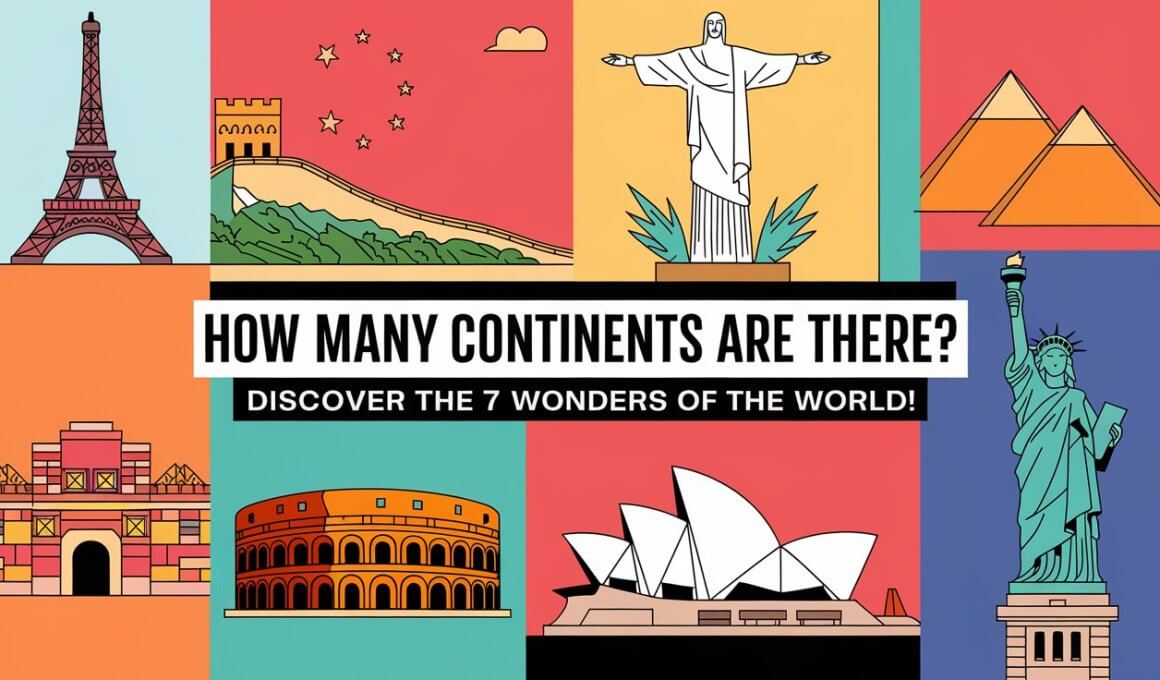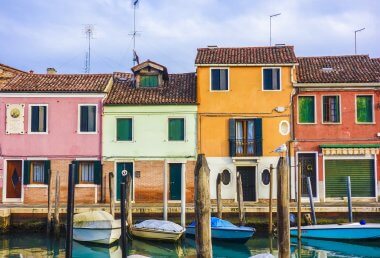There are 7 continents in the world:
- Africa
- Antarctica
- Asia
- Australia
- Europe
- North America
- South America
This is the most widely accepted model, taught in most English-speaking countries and many others worldwide. However, some countries use alternative models with 4, 5, or 6 continents, depending on how they group certain landmasses.
Have you ever wondered how many continents there are on Earth? As a passionate traveler, I’ve always been fascinated by the incredible diversity of our planet. From the vast savannas of Africa to the towering peaks of the Himalayas, each continent holds its own unique wonders. In this article, we’ll embark on a journey to discover the 7 continents that make up our world. We’ll explore their geographical features, cultural richness, and the awe-inspiring landscapes that define them. Whether you’re a seasoned globetrotter or an armchair adventurer, join me as we unravel the mysteries of the continents and learn what makes each one so special. Get ready to expand your horizons and fall in love with the beauty of our planet!
Exploring the 7 continents: a journey across the globe
Embark on an extraordinary adventure as we traverse the seven continents that make up our incredible planet. From the vast plains of Africa to the towering peaks of Asia, each continent boasts its own unique landscapes, cultures, and natural wonders. Let’s take a closer look at what makes each of these continents so special:
- Africa: Known for its diverse wildlife, ancient civilizations, and vibrant cultures, Africa is a continent that captures the imagination. Explore the majestic Sahara Desert, witness the great wildebeest migration in the Serengeti, and marvel at the pyramids of Egypt.
- Antarctica: The frozen continent of Antarctica is a land of extremes, with its pristine ice shelves, rugged mountains, and hardy wildlife. Despite its harsh conditions, this continent attracts adventurers and scientists alike, who come to study its unique ecosystems and experience its otherworldly beauty.
- Asia: As the largest and most populous continent, Asia is a melting pot of ancient traditions, modern innovations, and breathtaking landscapes. From the Great Wall of China to the temples of Angkor Wat, Asia offers an endless array of cultural and natural treasures to discover.
- Australia: The island continent of Australia is renowned for its laid-back lifestyle, stunning beaches, and unique wildlife. Dive into the colorful world of the Great Barrier Reef, explore the rugged outback, and encounter iconic animals like kangaroos and koalas.
- Europe: Steeped in history and brimming with cultural riches, Europe is a continent that has captivated travelers for centuries. Wander through the charming streets of Paris, admire the architectural wonders of Rome, and lose yourself in the natural beauty of the Swiss Alps.
- North America: From the skyscrapers of New York City to the pristine forests of Canada, North America offers a diverse array of landscapes and experiences. Explore the national parks of the United States, indulge in the vibrant culture of Mexico, and witness the awe-inspiring power of Niagara Falls.
- South America: A land of contrasts, South America boasts lush rainforests, towering peaks, and vibrant cities. Trek through the Amazon jungle, marvel at the ancient ruins of Machu Picchu, and dance to the rhythms of Rio de Janeiro.
As we journey across these seven continents, we discover the incredible diversity and beauty that our world has to offer. Each continent holds its own unique treasures, waiting to be explored and appreciated by those with a sense of adventure and a desire to learn. So pack your bags, grab your passport, and get ready to embark on the journey of a lifetime across the seven continents.
The great debate: how many continents are there?
While it may seem like a straightforward question, the number of continents on Earth has been a topic of debate among geographers and scientists for years. The most widely accepted view is that there are seven continents: Africa, Antarctica, Asia, Australia, Europe, North America, and South America. However, there are alternative models that propose different numbers of continents.
One alternative model suggests that there are six continents, combining Europe and Asia into a single continent called Eurasia. This model is based on the fact that Europe and Asia are located on the same landmass and share many cultural and historical ties. Another model proposes the existence of an eighth continent, Zealandia, which is largely submerged beneath the Pacific Ocean and includes New Zealand and New Caledonia.
The debate over the number of continents is further complicated by the fact that there is no universally agreed-upon definition of what constitutes a continent. Some geographers define continents based on physical characteristics, such as landmasses separated by oceans, while others consider cultural, political, and historical factors.
Despite the ongoing debate, the seven-continent model remains the most widely recognized and taught in schools around the world. This model is based on the following criteria:
- Each continent is a large, continuous landmass
- Each continent is separated from others by oceans
- Each continent has its own distinct geological, climatic, and ecological characteristics
While the debate over the number of continents may continue, it is important to recognize that each continent, regardless of how many are counted, plays a unique and vital role in the Earth’s ecosystem and in shaping human history and culture.
Unveiling the secrets of each continent
Each of the seven continents holds a wealth of secrets waiting to be discovered by curious explorers. From hidden natural wonders to ancient civilizations, every continent offers a unique tapestry of history, culture, and ecology. Let’s take a closer look at some of the most fascinating secrets each continent has to offer:
- Africa: This vast continent is home to some of the world’s oldest and most diverse cultures, as well as an incredible array of wildlife. Uncover the secrets of ancient Egyptian tombs, explore the lush rainforests of the Congo Basin, and witness the majestic beauty of the Serengeti’s great migration.
- Antarctica: The frozen continent of Antarctica holds secrets beneath its icy surface, including hidden lakes, unique microbial life, and clues to the Earth’s climate history. Discover the mysteries of this remote and inhospitable land, where scientists work to unravel the secrets of our planet’s past and future.
- Asia: From the ancient wisdom of Chinese medicine to the spiritual practices of Indian yoga, Asia is a continent rich in cultural and philosophical secrets. Explore the hidden temples of Angkor Wat, uncover the secrets of the Silk Road, and delve into the mystical traditions of the Himalayas.
- Australia: The island continent of Australia is home to some of the world’s most unique and fascinating wildlife, as well as the ancient secrets of the Aboriginal Dreamtime. Discover the hidden waterfalls and swimming holes of the Outback, explore the colorful depths of the Great Barrier Reef, and learn about the rich cultural heritage of Australia’s indigenous peoples.
- Europe: From the ancient ruins of Greece and Rome to the hidden gems of medieval villages, Europe is a continent steeped in history and cultural secrets. Uncover the mysteries of Stonehenge, explore the underground cities of Cappadocia, and discover the secret recipes behind Europe’s most beloved culinary traditions.
- North America: This diverse continent is home to a wealth of natural wonders and cultural secrets, from the ancient cliff dwellings of the American Southwest to the hidden speakeasies of the Prohibition era. Discover the secrets of the Mayan ruins, explore the misty forests of the Pacific Northwest, and uncover the hidden histories of North America’s great cities.
- South America: From the lost cities of the Inca to the mysterious geoglyphs of the Nazca Lines, South America is a continent rich in ancient secrets and natural wonders. Explore the lush Amazon rainforest, discover the hidden waterfalls of Iguazu, and uncover the cultural secrets of the continent’s vibrant indigenous communities.
As we unveil the secrets of each continent, we gain a deeper appreciation for the incredible diversity and richness of our world. By exploring these hidden treasures, we not only satisfy our curiosity but also broaden our understanding of the human experience and our place in the natural world.
From the largest to the smallest: ranking the continents by size
The seven continents vary greatly in size, from the vast expanses of Asia and Africa to the more modest landmasses of Europe and Australia. Here, we rank the continents by their total land area, from largest to smallest:
- Asia: With a total land area of approximately 44,579,000 square kilometers (17,212,000 square miles), Asia is the largest continent on Earth. It covers nearly one-third of the world’s total land area and is home to more than half of the global population.
- Africa: The second-largest continent, Africa covers an area of about 30,370,000 square kilometers (11,730,000 square miles). This vast landmass is known for its diverse landscapes, ranging from the Sahara Desert to the lush Congo Basin rainforest.
- North America: Covering an area of approximately 24,709,000 square kilometers (9,540,000 square miles), North America is the third-largest continent. It is known for its varied geography, including the Rocky Mountains, the Great Lakes, and the vast prairies of the United States and Canada.
- South America: The fourth-largest continent, South America covers an area of about 17,840,000 square kilometers (6,890,000 square miles). It is home to the Amazon rainforest, the Andes Mountains, and a wide range of unique wildlife species.
- Antarctica: Although it is covered in ice, Antarctica is considered the fifth-largest continent, with a total land area of about 14,200,000 square kilometers (5,500,000 square miles). This frozen continent is known for its harsh climate, stunning glaciers, and unique wildlife, such as penguins and seals.
- Europe: The sixth-largest continent, Europe covers an area of approximately 10,180,000 square kilometers (3,930,000 square miles). Despite its relatively small size, Europe is known for its rich history, diverse cultures, and iconic landmarks, such as the Eiffel Tower and the Colosseum.
- Australia: The smallest continent, Australia covers an area of about 7,692,000 square kilometers (2,969,000 square miles). This island continent is known for its unique wildlife, such as kangaroos and koalas, as well as its vast deserts and vibrant coral reefs.
It is important to note that these rankings are based on total land area and do not take into account the population, economic power, or cultural influence of each continent. Each continent, regardless of its size, plays a crucial role in the global ecosystem and contributes to the rich diversity of our planet.
The unique characteristics of each continent
Each of the seven continents boasts its own distinct set of characteristics that set it apart from the others. These unique features include diverse landscapes, climates, wildlife, and cultural heritage. Let’s explore some of the most notable characteristics of each continent:
- Africa: Known for its vast savannas, dense rainforests, and expansive deserts, Africa is home to an incredible array of wildlife, including iconic species such as lions, elephants, and gorillas. The continent also boasts a rich cultural diversity, with thousands of indigenous tribes and languages.
- Antarctica: This frozen continent is characterized by its ice sheets, glaciers, and extreme cold temperatures. Despite its harsh environment, Antarctica supports a unique ecosystem of wildlife, including penguins, seals, and whales. It also plays a crucial role in global climate research.
- Asia: As the largest and most populous continent, Asia is known for its diverse landscapes, ranging from the towering peaks of the Himalayas to the tropical islands of Southeast Asia. The continent is also home to some of the world’s oldest civilizations and most influential religions, such as Buddhism and Hinduism.
- Australia: The island continent of Australia is characterized by its vast deserts, unique wildlife, and vibrant coral reefs. It is home to many endemic species, such as kangaroos, koalas, and platypuses. Australia also has a strong indigenous culture, with Aboriginal communities dating back over 60,000 years.
- Europe: Known for its rich history, diverse cultures, and iconic architecture, Europe is a continent of contrasts. From the fjords of Norway to the Mediterranean coastlines of Italy and Greece, Europe boasts a wide range of landscapes and climates. The continent has also been at the forefront of art, science, and innovation for centuries.
- North America: Characterized by its vast prairies, towering mountain ranges, and lush forests, North America is a continent of diverse landscapes and wildlife. It is home to iconic species such as bison, grizzly bears, and bald eagles. North America also has a rich cultural heritage, with influences from indigenous, European, and African communities.
- South America: Known for its lush Amazon rainforest, towering Andes Mountains, and vibrant cultures, South America is a continent of incredible diversity. It is home to a wide range of unique wildlife, such as jaguars, anacondas, and toucans. South America also boasts a rich indigenous heritage, with ancient civilizations such as the Inca and the Mapuche.
These unique characteristics showcase the incredible diversity of our planet and highlight the importance of preserving and celebrating the natural and cultural heritage of each continent.
Continent or not? The curious cases of Zealandia and Antarctica
While the seven-continent model is widely accepted, there are two landmasses that often spark debate among geographers and scientists: Zealandia and Antarctica.
Zealandia, also known as Te Riu-a-Māui or Tasmantis, is a largely submerged landmass in the Pacific Ocean. It includes the islands of New Zealand and New Caledonia, as well as several smaller islands and underwater plateaus. In 2017, a group of scientists argued that Zealandia meets the criteria for being considered a continent, based on its distinct geology and the fact that it is a large, continuous landmass. However, this claim remains controversial, as much of Zealandia is underwater and its total land area is much smaller than that of the other continents.
Antarctica, on the other hand, is widely recognized as a continent, but its unique characteristics set it apart from the others. Unlike the other continents, Antarctica has no permanent human population and is governed by an international treaty that sets aside the continent for peaceful scientific research. Its harsh, cold climate and remote location make it a challenging environment for life to thrive. However, Antarctica plays a crucial role in the Earth’s climate system and is home to unique wildlife, such as penguins, seals, and whales.
The debate surrounding Zealandia and Antarctica highlights the complexity of defining and classifying continents. While the seven-continent model remains the most widely accepted, it is important to acknowledge the unique geological and ecological characteristics of these landmasses and their significance in the study of our planet.
The ever-changing world: how continents have evolved over time
The continents we know today have not always been in their current positions or shapes. Over millions of years, the Earth’s landmasses have undergone significant changes due to the constant movement of tectonic plates. This process, known as continental drift, has shaped the world we live in and continues to do so today.
The theory of continental drift was first proposed by German scientist Alfred Wegener in 1912. He noticed that the coastlines of continents like South America and Africa seemed to fit together like puzzle pieces. Wegener suggested that the continents were once connected in a single supercontinent called Pangaea, which began to break apart about 200 million years ago.
Since then, the continents have continued to move and change shape. For example:
- The Atlantic Ocean has been widening as North America and Europe move away from each other at a rate of about 2.5 centimeters per year.
- The Himalayan Mountains are still rising as the Indian subcontinent collides with Asia.
- The African Rift Valley is slowly splitting the continent apart, which may eventually lead to the formation of a new ocean.
These changes are driven by the movement of the Earth’s lithosphere, which is divided into several large tectonic plates. As these plates move and interact with each other, they cause earthquakes, volcanic eruptions, and the formation of mountains and ocean basins.
The evolution of continents has not only shaped the physical world but has also influenced the distribution and diversity of life on Earth. As continents have moved and climates have changed, species have adapted, migrated, or gone extinct, leading to the incredible variety of flora and fauna we see today.
Understanding the dynamic nature of our planet and how continents have evolved over time is crucial for predicting future changes and their potential impacts on the environment and human society. By studying the Earth’s past, we can better prepare for the challenges and opportunities that lie ahead in our ever-changing world.
Biodiversity hotspots: the incredible flora and fauna of each continent
Each continent boasts an incredible array of unique and diverse plant and animal species, many of which are found nowhere else on Earth. These biodiversity hotspots are crucial for maintaining the health and balance of our planet’s ecosystems. Let’s explore some of the most remarkable examples of flora and fauna from each continent:
- Africa: The African continent is home to an astonishing variety of wildlife, from the majestic lions and elephants of the savannas to the gorillas and chimpanzees of the rainforests. The island of Madagascar is a biodiversity hotspot, with over 90% of its wildlife found nowhere else on Earth, including lemurs and the baobab tree.
- Antarctica: Despite its harsh, frozen environment, Antarctica supports a surprising diversity of life. The continent is home to unique species such as emperor penguins, Weddell seals, and the Antarctic hairgrass, one of the only two flowering plants found on the continent.
- Asia: Asia’s diverse landscapes and climates support an incredible range of biodiversity. The tropical rainforests of Southeast Asia are home to orangutans, gibbons, and the rafflesia, the world’s largest flower. The mountains of central Asia support unique species like the snow leopard and the Himalayan yak.
- Australia: Australia’s isolation has led to the evolution of many unique and endemic species, such as kangaroos, koalas, and the platypus. The continent is also home to the Great Barrier Reef, the world’s largest coral reef system and a biodiversity hotspot for marine life.
- Europe: While Europe has been heavily influenced by human activity, it still boasts a rich diversity of flora and fauna. The continent is home to iconic species such as the European bison, the Eurasian lynx, and the edelweiss flower, which grows in the alpine regions of the Alps.
- North America: North America’s varied landscapes support a wide range of biodiversity, from the bison and grizzly bears of the Great Plains to the redwood forests of the Pacific Northwest. The continent is also a crucial breeding ground for migratory birds, such as the monarch butterfly and the Arctic tern.
- South America: South America’s Amazon rainforest is one of the most biodiverse regions on Earth, home to an estimated 10% of the world’s known species, including jaguars, sloths, and the giant water lily. The Andes Mountains also support unique species, such as the Andean condor and the chinchilla.
Protecting these biodiversity hotspots is crucial for maintaining the health and resilience of our planet’s ecosystems. By conserving habitats and supporting sustainable practices, we can ensure that the incredible flora and fauna of each continent continue to thrive for generations to come.
Cultural kaleidoscope: the diverse peoples and traditions of the continents
The continents of the world are not only home to a rich diversity of flora and fauna but also to an incredible array of human cultures and traditions. Each continent has its own unique history, languages, religions, and customs that have shaped the lives of its inhabitants for thousands of years. Let’s take a closer look at the cultural diversity of each continent:
- Africa: With over 1.2 billion people and more than 3,000 distinct ethnic groups, Africa is a continent of incredible cultural diversity. From the ancient civilizations of Egypt and Ethiopia to the vibrant traditions of West African music and dance, African cultures have made an indelible mark on the world.
- Antarctica: While Antarctica has no permanent human population, it has a unique cultural heritage shaped by the explorers, scientists, and support staff who have lived and worked on the continent. The Antarctic Treaty ensures that the continent remains a place of peace, scientific research, and international cooperation.
- Asia: As the world’s largest and most populous continent, Asia is home to an astonishing diversity of cultures, from the ancient civilizations of China and India to the modern metropolises of Japan and South Korea. Asian cultures have given the world everything from Buddhism and Hinduism to martial arts and anime.
- Australia: Australia’s indigenous cultures, including Aboriginal and Torres Strait Islander peoples, have thrived on the continent for over 60,000 years. These cultures have a deep spiritual connection to the land and have developed unique art forms, such as dot painting and didgeridoo music.
- Europe: Europe’s cultural heritage is a fascinating mix of ancient civilizations, such as the Greeks and Romans, and modern nation-states. European cultures have given the world everything from classical music and impressionist art to democracy and the scientific method.
- North America: North America’s cultural diversity is a reflection of its history of immigration and conquest. From the indigenous cultures of the Native Americans to the African American, Latino, and Asian American communities, North American cultures have created a vibrant tapestry of music, art, and cuisine.
- South America: South America’s cultural heritage is a rich blend of indigenous, European, and African influences. From the ancient Inca and Maya civilizations to the modern-day samba and tango, South American cultures have a passion for music, dance, and celebration.
By exploring and celebrating the cultural diversity of each continent, we can gain a deeper understanding and appreciation of the human experience. Through the sharing of ideas, traditions, and values, we can build bridges of understanding and create a more harmonious world.
Extreme landscapes: the most stunning natural wonders of each continent
From towering mountains to vast deserts, each continent boasts its own unique set of natural wonders that showcase the breathtaking beauty and power of the Earth. These extreme landscapes have captivated the hearts and minds of people for centuries, inspiring awe, adventure, and a deep appreciation for the natural world. Let’s explore some of the most stunning natural wonders of each continent:
- Africa: The Sahara Desert, the largest hot desert in the world, covers much of North Africa and is home to towering sand dunes, rocky plateaus, and ancient rock art. In contrast, the lush rainforests of the Congo Basin are teeming with life, including gorillas, chimpanzees, and countless species of plants and insects.
- Antarctica: The frozen continent of Antarctica is home to some of the most extreme landscapes on Earth, from the towering peaks of the Transantarctic Mountains to the vast ice shelves that extend out into the Southern Ocean. The continent also boasts stunning glaciers, such as the Beardmore Glacier, which stretches over 100 miles long.
- Asia: Asia is home to some of the world’s highest mountains, including Mount Everest, the tallest peak on Earth. The continent also boasts stunning natural wonders like the colorful travertine terraces of Pamukkale in Turkey and the otherworldly karst landscapes of Guilin in China.
- Australia: Australia’s natural wonders are as diverse as the continent itself, from the vibrant colors of the Great Barrier Reef to the rugged beauty of the Outback. The continent is also home to unique geological formations, such as the wave-like rock formations of the Bungle Bungle Range and the towering sandstone pillars of the Twelve Apostles.
- Europe: Europe may be the second smallest continent, but it is home to some of the world’s most stunning natural wonders, from the rugged fjords of Norway to the snow-capped peaks of the Alps. The continent also boasts unique geological formations, such as the basalt columns of Giant’s Causeway in Ireland and the otherworldly geothermal landscapes of Iceland.
- North America: North America is home to some of the world’s most iconic natural wonders, from the towering redwoods of California to the thundering waters of Niagara Falls. The continent also boasts stunning geological formations, such as the colorful hoodoos of Bryce Canyon and the vast salt flats of Death Valley.
- South America: South America is a continent of superlatives, from the highest waterfall (Angel Falls in Venezuela) to the driest desert (the Atacama in Chile). The continent also boasts stunning natural wonders like the vibrant colors of the Caño Cristales River in Colombia and the vast glaciers of Patagonia in Argentina and Chile.
These extreme landscapes not only showcase the incredible diversity and beauty of the Earth but also remind us of the importance of preserving and protecting these natural wonders for future generations to enjoy and appreciate.
The role of continents in shaping human history and civilization
The continents have played a crucial role in shaping the course of human history and the development of civilizations. The unique geography, climate, and resources of each continent have influenced the way societies have evolved, interacted, and progressed over time. Let’s explore how each continent has contributed to the story of human civilization:
- Africa: As the birthplace of humanity, Africa has a long and complex history that has shaped the world we know today. From the ancient civilizations of Egypt and Nubia to the powerful empires of Mali and Songhai, Africa has been a center of innovation, trade, and cultural exchange for millennia.
- Antarctica: While Antarctica has no indigenous human population, it has played a significant role in the history of exploration and scientific discovery. The continent’s harsh environment and unique geography have challenged and inspired generations of explorers, from the early expeditions of Scott and Amundsen to the scientific research stations of today.
- Asia: As the largest and most populous continent, Asia has been home to some of the world’s oldest and most influential civilizations, from the ancient empires of China and India to the modern-day powerhouses of Japan and South Korea. Asian cultures have made countless contributions to art, science, philosophy, and religion, shaping the course of human history in profound ways.
- Australia: Australia’s unique geography and isolation have shaped the development of its indigenous cultures and the course of its modern history. From the ancient Dreamtime stories of the Aboriginal people to the country’s role in World War II and beyond, Australia has played a significant role in shaping the Asia-Pacific region and the world at large.
- Europe: Europe has been a center of cultural, economic, and political power for centuries, from the ancient civilizations of Greece and Rome to the colonial empires of the 19th and 20th centuries. European ideas and innovations, from the Renaissance and the Enlightenment to the Industrial Revolution and beyond, have had a profound impact on the course of human history.
- North America: North America’s vast resources and unique geography have shaped the development of its indigenous cultures and the course of its modern history. From the ancient civilizations of the Maya and the Aztec to the United States’ rise to global superpower status, North America has played a significant role in shaping the world we know today.
- South America: South America’s rich history and cultural diversity have been shaped by the interplay of indigenous, European, and African influences. From the ancient Inca Empire to the modern-day nations of Brazil, Argentina, and Colombia, South America has made significant contributions to art, literature, music, and politics, enriching the tapestry of human civilization.
By understanding the role of continents in shaping human history and civilization, we can gain a deeper appreciation for the diversity and complexity of the human experience. Each continent has a unique story to tell, and by exploring these stories, we can build a more complete and nuanced understanding of our shared history and our common future.
Continent hopping: the ultimate travel bucket list
For the adventurous traveler, exploring all seven continents is the ultimate goal. Each continent offers its own unique blend of natural beauty, cultural richness, and unforgettable experiences. Here’s a continent-hopping travel bucket list that will inspire you to pack your bags and set off on a journey of a lifetime:
- Africa: Go on a safari in the Serengeti, climb Mount Kilimanjaro, marvel at the pyramids of Egypt, and explore the vibrant cities of Cape Town and Marrakech.
- Antarctica: Brave the icy wilderness on an expedition cruise, witness the majestic beauty of icebergs and glaciers, and encounter unique wildlife like penguins, seals, and whales.
- Asia: Walk along the Great Wall of China, explore the ancient temples of Angkor Wat, trek through the Himalayas, and immerse yourself in the bustling cities of Tokyo, Bangkok, and Mumbai.
- Australia: Dive into the Great Barrier Reef, road trip through the Outback, explore the vibrant cities of Sydney and Melbourne, and learn about Aboriginal culture in Uluru.
- Europe: Marvel at the art and architecture of Paris, Rome, and Barcelona; hike through the Swiss Alps; explore the historic cities of Prague and Budapest; and witness the northern lights in Iceland.
- North America: Road trip through the national parks of the United States, explore the vibrant cities of New York and San Francisco, ski in the Canadian Rockies, and discover the ancient ruins of Mexico.
- South America: Trek to Machu Picchu, explore the Amazon rainforest, dance the tango in Buenos Aires, and marvel at the stunning landscapes of Patagonia.
Of course, this is just a small sample of the countless adventures each continent has to offer. The beauty of continent hopping is that it allows you to experience the incredible diversity of our planet, from the natural wonders and cultural treasures to the local cuisines and friendly faces.
So why not start planning your own continent-hopping adventure today? With a little bit of research and a lot of enthusiasm, you can create a travel bucket list that will take you to the far corners of the Earth and back again. Happy travels!
The future of the continents: challenges and opportunities
As the world continues to evolve and change, the future of the continents is shaped by a complex interplay of challenges and opportunities. From climate change and resource scarcity to technological innovation and cultural exchange, the coming decades will bring both obstacles and possibilities for the people and ecosystems of each continent.
One of the greatest challenges facing the continents is climate change. Rising temperatures, sea levels, and extreme weather events are already having a profound impact on the world’s landscapes, communities, and economies. From the melting glaciers of Antarctica to the drought-stricken savannas of Africa, the effects of climate change are being felt across the globe. To address this challenge, the continents will need to work together to reduce greenhouse gas emissions, promote sustainable development, and build resilience to the impacts of a changing climate.
Another key challenge is resource scarcity. As the world’s population continues to grow and demand for resources like water, food, and energy increases, the continents will need to find ways to manage these resources more sustainably and equitably. This will require innovative solutions, such as precision agriculture, renewable energy, and circular economies, as well as greater cooperation and collaboration among nations and communities.
At the same time, the continents also face significant opportunities for growth, development, and progress. Advances in technology, such as artificial intelligence, biotechnology, and renewable energy, are creating new possibilities for economic growth, social progress, and environmental sustainability. The continents are also becoming more interconnected than ever before, with increasing trade, travel, and cultural exchange fostering greater understanding and cooperation among peoples and nations.
To seize these opportunities and overcome the challenges of the future, the continents will need to work together in new and innovative ways. This will require greater investment in education, research, and development, as well as more inclusive and participatory forms of governance and decision-making. It will also require a shared commitment to the values of sustainability, equity, and resilience, as well as a willingness to learn from and celebrate the diversity of cultures and perspectives that make up our global community.
Ultimately, the future of the continents will be shaped by the choices and actions of people and communities around the world. By working together to address the challenges and seize the opportunities of the coming decades, we can create a more sustainable, equitable, and prosperous future for all.
Continents in numbers: fascinating facts and statistics
The world’s continents are not only diverse in terms of geography, culture, and history but also in terms of their size, population, and other fascinating statistics. Here are some intriguing facts and figures about each continent:
- Africa:
- Area: 30.37 million km² (11.7 million mi²)
- Population: 1.3 billion (as of 2021)
- Number of countries: 54
- Largest city: Lagos, Nigeria (21 million inhabitants)
- Antarctica:
- Area: 14.2 million km² (5.5 million mi²)
- Population: 0 permanent inhabitants, up to 5,000 temporary residents
- Lowest recorded temperature: -89.2°C (-128.6°F)
- Largest ice shelf: Ross Ice Shelf (472,000 km² or 182,000 mi²)
- Asia:
- Area: 44.58 million km² (17.2 million mi²)
- Population: 4.6 billion (as of 2021)
- Number of countries: 48
- Highest point: Mount Everest, 8,848 meters (29,029 ft) above sea level
- Australia:
- Area: 8.6 million km² (3.3 million mi²)
- Population: 25.69 million (as of 2021)
- Number of countries: 3 (Australia, Papua New Guinea, and portions of Indonesia)
- Largest coral reef system: Great Barrier Reef, over 2,300 km (1,400 mi) long
- Europe:
- Area: 10.18 million km² (3.9 million mi²)
- Population: 746.4 million (as of 2021)
- Number of countries: 44
- Smallest country: Vatican City, 0.44 km² (0.17 mi²)
- North America:
- Area: 24.71 million km² (9.5 million mi²)
- Population: 592.3 million (as of 2021)
- Number of countries: 23
- Largest freshwater lake: Lake Superior, 82,100 km² (31,700 mi²)
- South America:
- Area: 17.84 million km² (6.9 million mi²)
- Population: 430.8 million (as of 2021)
- Number of countries: 12
- Largest river by volume: Amazon River, discharging 209,000 m³/s (7.4 million ft³/s)
These fascinating facts and statistics offer a glimpse into the incredible diversity and scale of the world’s continents. From the vast ice sheets of Antarctica to the teeming cities of Asia, each continent has its own unique characteristics and contributions to the global landscape.
Embark on Your Own Continental Adventure
From the towering peaks of Asia to the vast savannas of Africa, the world’s continents are a testament to the incredible diversity and beauty of our planet. Each continent has its own unique history, culture, and natural wonders, offering endless opportunities for exploration and discovery. Whether you’re a seasoned traveler or an armchair adventurer, learning about the continents is a fascinating journey that can broaden your horizons and deepen your appreciation for the world around you.
So why not start your own continental adventure today? With Skysonar.com, you can easily compare flight prices and find the best deals on airfare to destinations across all seven continents. From the bustling cities of Europe to the remote wilderness of Antarctica, Skysonar.com makes it easy to plan your dream trip and discover the wonders of the world. Start exploring now and let your continental journey begin!
Embark on Your Own Continental Adventure
From the towering peaks of Asia to the vast savannas of Africa, the world’s continents are a testament to the incredible diversity and beauty of our planet. Each continent has its own unique history, culture, and natural wonders, offering endless opportunities for exploration and discovery. Whether you’re a seasoned traveler or an armchair adventurer, learning about the continents is a fascinating journey that can broaden your horizons and deepen your appreciation for the world around you.
So why not start your own continental adventure today? With Skysonar.com, you can easily compare flight prices and find the best deals on airfare to destinations across all seven continents. From the bustling cities of Europe to the remote wilderness of Antarctica, Skysonar.com makes it easy to plan your dream trip and discover the wonders of the world. Start exploring now and let your continental journey begin!
Frequently Asked Questions
How many continents are there in the world?
There are seven continents in the world: Africa, Antarctica, Asia, Australia, Europe, North America, and South America. However, some models combine Europe and Asia into a single continent called Eurasia, while others consider North and South America as one American continent.
What is the largest continent by land area?
Asia is the largest continent by land area, covering approximately 44,579,000 square kilometers (17,212,000 square miles). It is home to more than half of the world’s population and includes countries such as China, India, and Russia.
What is the smallest continent by land area?
Australia is the smallest continent by land area, covering approximately 7,692,000 square kilometers (2,969,000 square miles). It is also the flattest and driest inhabited continent, with unique wildlife and landscapes found nowhere else on Earth.
Which continent has the most countries?
Africa has the most countries of any continent, with 54 recognized sovereign states. These countries range in size from the vast deserts of Algeria to the tiny island nation of Seychelles, and are home to a diverse array of cultures, languages, and traditions.
What is the most populous continent?
Asia is the most populous continent, with over 4.6 billion people as of 2021. This represents more than 60% of the world’s total population. China and India, both located in Asia, are the two most populous countries in the world.
Are there any continents without permanent human inhabitants?
Yes, Antarctica is the only continent without permanent human inhabitants. While there are several research stations scattered across the continent, these are only inhabited by scientists and support staff on a temporary basis. The harsh climate and remote location make permanent settlement difficult.








